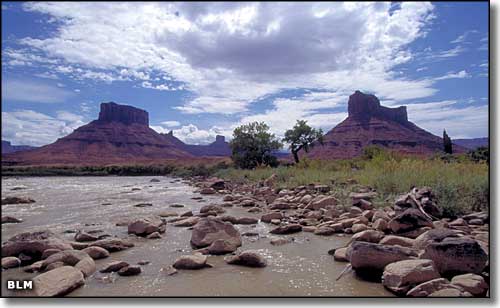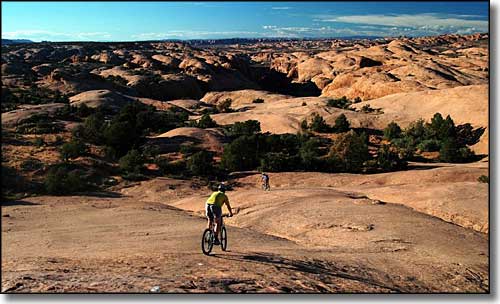
Moab, Utah

The Colorado River near Moab
Moab has become a destination city with Arches National Park, Canyonlands National Park and the incredible vistas offered by Dead Horse Point State Park, plus numerous world-renowned mountain biking trails nearby. There's also several levels of whitewater rafting available in the area on the Colorado and Green Rivers. Then there's off-roaders who come for the annual Moab Jeep Safari and various rock-crawling competitions.
Moab was established near a good, natural crossing of the Colorado River along the Old Spanish Trail. There were a couple of previous attempts to establish trading settlements here but they were abandoned after coming under near-constant Indian attack. A permanent settlement finally began in 1878 as the Indian Wars were finally winding down.
Moab was originally an agricultural settlement but the importance of mining grew over the years. Vanadium and uranium were discovered in the 1910's and 1920's, then potash and manganese, then oil and natural gas. In the 1950's, geologist Charles Steen discovered a rich lode of uranium ore south of Moab and that turned the city into the Uranium Capital of the World. The population boomed and Moab was pretty prosperous, until the United States and Russia began to successfully negotiate the phasing out of their nuclear weapons arsenals. Uranium mining began to die off right there. By the early 1980's, nearly all the uranium mines were closed and half the houses in Moab were abandoned.
Hollywood discovered Moab in 1949 when director John Ford filmed Wagon Master here. The area has been used for quite a number of films since. But real prosperity didn't start to return until the 1970's when Moab began to develop as a recreational center.
These days, Moab has also developed as a popular second-home location. There's been a lot of local controversy over these temporary citizens and their hardly-lived-in homes, especially in the aftermath of the mortgage and economic disaster.

The famous Slickrock Bike Trail near Moab
Latitude: 38.5725°N
Longitude: 109.5498°W
Incorporated: 1902
Elevation: 4,026'
Education:
High School or Higher: 81.2%
Bachelor's Degree or Higher: 20.9%
Graduate or Professional Degree: 8.0%
2011 Cost of Living Index for Moab: 85.7
Median Resident Age: 35.5 Years
Estimated Median Household Income: $34,600
Estimated Median Home Value: $191,200
Population Density: 1,415 People per Square Mile
Major Industries:
Lodging & Food Services, Construction, Educational Services, Health Care, Arts, Entertainment & Recreation, Government, Social Services, Professional Services, Retail Services, Agriculture
Unemployed (March 2011): 12.3%
Population Demographics: 2010
| Total Population | 5,046 |
| Males | 2,496 |
| Females | 2,550 |
| Population by Age | |
| Under 18 | 1,213 |
| 18 & over | 3,833 |
| 20-24 | 298 |
| 25-34 | 733 |
| 35-49 | 1,017 |
| 50-64 | 1,019 |
| 65 & over | 657 |
| Population by Ethnicity | |
| Hispanic or Latino | 646 |
| Non Hispanic or Latino | 4,400 |
| Population by Race | |
| White | 4,306 |
| African-American | 22 |
| Asian | 44 |
| Native American | 297 |
| Hawaiian or Pacific Islander | 3 |
| Other | 276 |
| Two or more | 98 |
